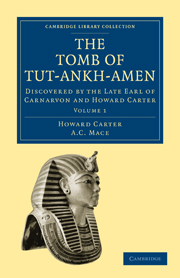Book contents
- Frontmatter
- Preface
- Contents
- LIST OF PLATES
- INTRODUCTION. BIOGRAPHICAL SKETCH OF THE LATE LORD CARNARVON
- CHAPTER 1 THE KING AND THE QUEEN
- CHAPTER 2 THE VALLEY AND THE TOMB
- CHAPTER 3 THE VALLEY IN MODERN TIMES
- CHAPTER 4 OUR PREFATORY WORK AT THEBES
- CHAPTER 5 THE FINDING OF THE TOMB
- CHAPTER 6 A PRELIMINARY INVESTIGATION
- CHAPTER 7 A SURVEY OF THE ANTECAMBER
- CHAPTER 8 CLEARING THE ANTECHAMBER
- CHAPTER 9 VISITORS AND THE PRESS
- CHAPTER 10 WORK IN THE LABORATORY
- CHAPTER 11 THE OPENING OF THE SEALED DOOR
- APPENDIX
- INDEX
- Plate section
- Plate section
CHAPTER 1 - THE KING AND THE QUEEN
Published online by Cambridge University Press: 07 October 2011
- Frontmatter
- Preface
- Contents
- LIST OF PLATES
- INTRODUCTION. BIOGRAPHICAL SKETCH OF THE LATE LORD CARNARVON
- CHAPTER 1 THE KING AND THE QUEEN
- CHAPTER 2 THE VALLEY AND THE TOMB
- CHAPTER 3 THE VALLEY IN MODERN TIMES
- CHAPTER 4 OUR PREFATORY WORK AT THEBES
- CHAPTER 5 THE FINDING OF THE TOMB
- CHAPTER 6 A PRELIMINARY INVESTIGATION
- CHAPTER 7 A SURVEY OF THE ANTECAMBER
- CHAPTER 8 CLEARING THE ANTECHAMBER
- CHAPTER 9 VISITORS AND THE PRESS
- CHAPTER 10 WORK IN THE LABORATORY
- CHAPTER 11 THE OPENING OF THE SEALED DOOR
- APPENDIX
- INDEX
- Plate section
- Plate section
Summary
A few preliminary words about Tut-ankh-Amen, the king whose name the whole world knows, and who in that sense probably needs an introduction less than anyone in history. He was the son-in-law, as everyone knows, of that most written-about, and probably most overrated, of all the Egyptian Pharaohs, the heretic king Akh en Aten. Of his parentage we know nothing. He may have been of the blood royal and had some indirect claim to the throne on his own account. He may on the other hand have been a mere commoner. The point is immaterial, for, by his marriage to a king's daughter, he at once, by Egyptian law of succession, became a potential heir to the throne. A hazardous and uncomfortable position it must have been to fill at this particular stage of his country's history. Abroad, the Empire founded in the fifteenth century B.C. by Thothmes III, and held, with difficulty it is true, but still held, by succeeding monarchs, had crumpled up like a pricked balloon. At home dissatisfaction was rife. The priests of the ancient faith, who had seen their gods flouted and their very livelihood compromised, were straining at the leash, only waiting the most convenient moment to slip it altogether: the soldier class, condemned to a mortified inaction, were seething with discontent, and apt for any form of excitement.
- Type
- Chapter
- Information
- The Tomb of Tut-Ankh-AmenDiscovered by the Late Earl of Carnarvon and Howard Carter, pp. 41 - 49Publisher: Cambridge University PressPrint publication year: 2010First published in: 1923



